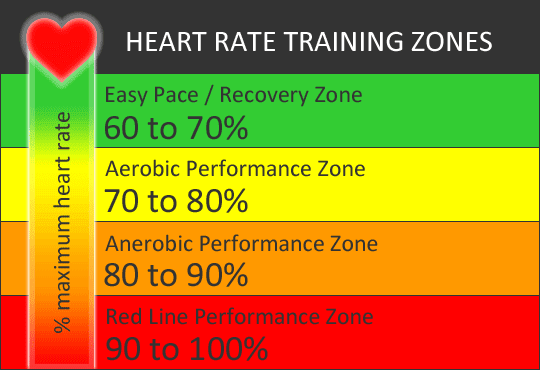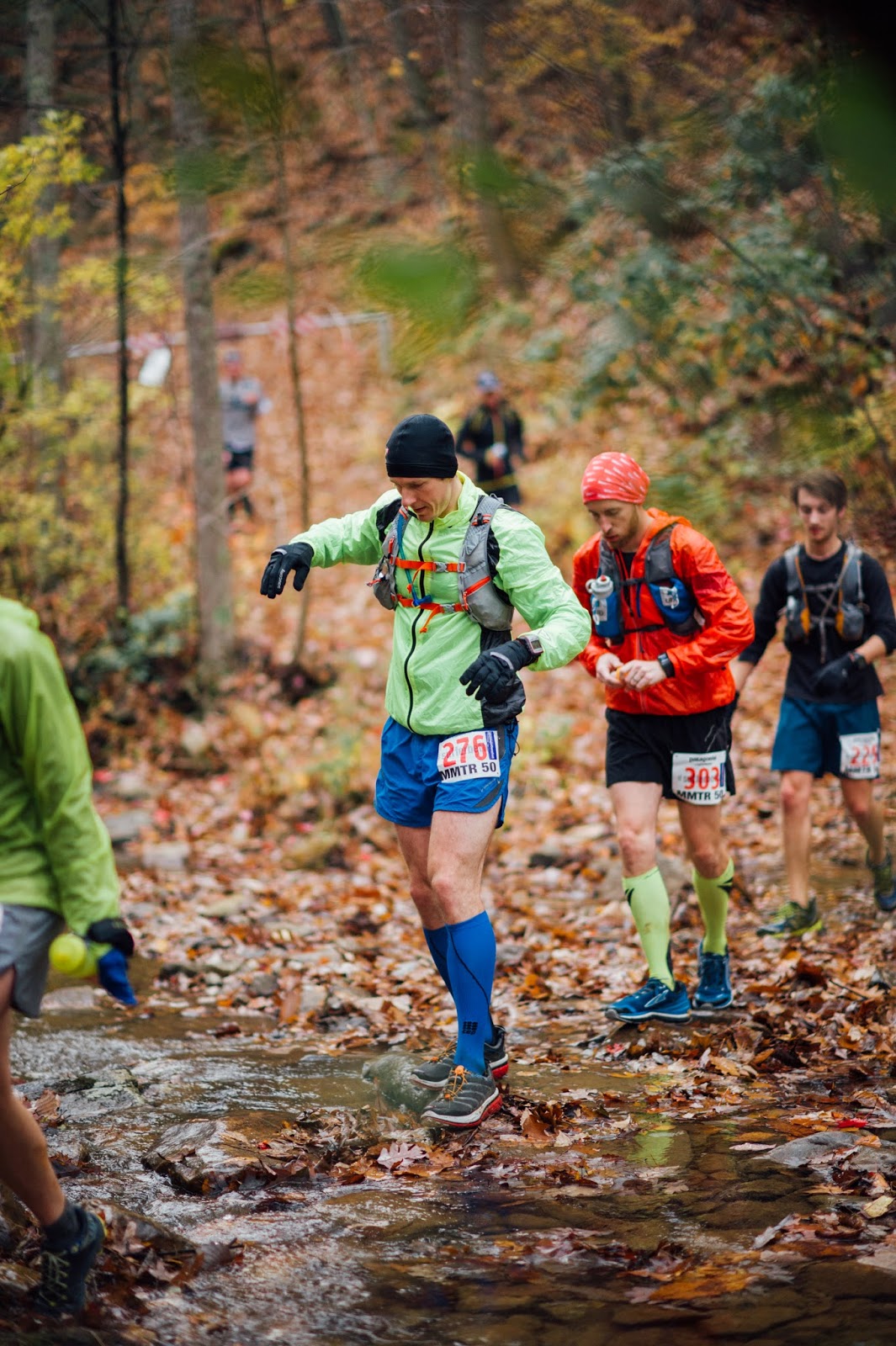The
Big Horn "wild and scenic" 100 mile trail run. This was the one. If there was ever a goal race, a travel race, an experience: this was it.
Race:
Big Horn 100 miler
Location:
Dayton, Wyoming (Big Horn Mountains)
Date: June 19-20, 2015
Gain/Loss: 18,300 ft
Altitude: 4,000 ft to 9,000 ft
Time:
30:17:22
 |
When you finish a marathon you get a medal. When you
finish 100 miles you get a belt buckle! |
Intro
Though the race didn't start until Friday, we flew into Billings, Montana Wednesday night and drove down to Sheridan, Wyoming with some minor sightseeing along the way. This was not only a requirement, since packet pickup and drop bag checking was Thursday afternoon, but served as a great buffer before the race to get adjusted to the local area. In hindsight, I think getting not only 1, but 2 solid nights of sleep before the race was a huge helper. I don't really recall being extremely sleepy at any point during the race.
Most of the cities out there are pretty abbreviated, but Sheridan did have a cute main street strip with a local festival going on. There were a few options for western looking saloons and bars that I was eager to explore, however I wisely held off with the 100 miler looming. The pasta dine-in on Thursday night gave us a great chance to catch up with the many other VA/DC/MD runners who made the trek out. The
Virginia Happy Trails Running Club coordinates an unofficial "travel race" every year; Big Horn was this year's and club members were out in full force. It was scenic, different, and offered 18, 32, 52 and 100 mile distances.
 |
| A large group of runners representing the VA/DC/MD area from VHTRC. |
After dinner was over I was really just anxious to get the race started. I had no problem going to sleep on time and rising refreshed before heading to finish area in Dayton for the pre-race briefing. We then caravaned to the race start, 5 miles deeper into the Tongue River Canyon where the first of many iconic rock formations awaited us.
I have pretty specific preferences as far as what equipment and fuel I use during a race, but overall its pretty varied from runner to runner. While a common reaction to heat and extreme sun is to strip down, at a a certain point it is wiser to cover back up, namely with white or light colored clothing. The sun can zap your energy levels, burn your skin, and suck out moisture. Staying hydrated and cool is critical. Dry air and light wind can fool you into thinking you aren't overheating, but once the wind stops you realize how intense the sun really is. I wore a white tech T (moisture whicking shirt), a dorky looking white hat with ear and neck cover (to keep the sun off - also wore sunglasses), and I even used white arm sleeves for this race. Being fare skinned and with blue eyes requires a little extra protection. These arm sleeves are popular with cyclists doing day long rides to keep the sun off their arms and they worked great. If you dip them in water and keep them wet they actually have a cooling affect on your arms in dry conditions. I left my legs bare but put plenty of sunscreen on to all exposed areas, reapplying through the day. Some people headed out with tank tops or even shirtless (assuming they would cover up later in the race), but I couldn't imagine being so exposed even for an hour.
I run with a
Salomon hydration vest to refuel and carry some necessities. The bladder holds 1.5 liters of water and I was refueling at every aid station. Some people were getting by with just a hand bottle but I simply drink too much to make that work. In my pack I also carry a lightweight shell jacket and knit hat in case the weather abruptly turns afoul. In terms of food, I like to bring a few bars (Lara-bars and Cliff bars), a couple energy gels (like Gu), and some salt tablets to keep my salt and electrolyte levels up (
S!Caps are pretty standard with ultra runners). You want to at least attempt to eat and drink enough that you never really get to a point of being severely thirsty or hungry. While gels and bars won't really sustain you the whole race, the aid stations have "real" food available. I also have some spare toilet paper (just in case), chapstick, and my cell phone (mostly for picture taking, but also doubles as a music player).
Start to Dry Fork (0 - 13.4 miles)
 |
| Just before the start. |
The starting line to the 100 miler was simple, just a few hundred runners competing for what little shade was available before saying goodbye to the many supporters who were also there. The gun went off at 11:00am, as we were approaching the hottest part of the day. This was a unique start time; most races tend to start early in the morning but I was happy with the 11:00am start as it facilitated another full night of sleep.

A few of my friends of similar abilities laid out a plan to loosely stay together at least for the first 1/3 of the race. While the goal of a pace group in a road marathon may be to keep everyone in check and running fast enough, its quite the opposite in an Ultra. Here we were trying to stay honest in going out slowly enough. Going out too fast, even just slightly, in a race this long can result in significant fatigue later in the race. That fatigue can set in as early as 25 miles, after the half-way mark, or even in the closing 20 miles of the race; not something I wanted to experience. The heat, sun, and exposure only compounded the need to take it easy and take it plenty of fluids.
 |
Running through the Tongue
River Canyon. |
As we got started I was immediately struck by the landscape. Full of rock formations and high country open spaces I knew I wasn't running in Virginia anymore. We had some rolling hills in the canyon before starting some major climbs to get up into some alpine meadows. Now the real mountains were coming into view. We continued up and down a mix of single track trails and dirt roads, passing some minor aid stations before we reached the first major aid station, Dry Fork. The minor aid stations typically offer water, an electrolyte drink (like gatorade), and some snacks; one would be wise to be eating, drinking, and refilling your pack at every chance, especially during the heat of the day. The major aid stations were almost like little villages, with volunteers running around tending to the food & drink, race officials checking on your bib number and time, supporters offering up words of advice, and even medical personnel to keep an eye on anything out of the ordinary.
Dry Fork to Footbridge (13.4 - 30 mi)
 |
| Heading up some of the many hills. |
For the Dry Fork aid station, as with any aid station, I had a plan ahead of time. This consists of getting in and out as fast as possible, while taking the time to get everything I needed. Basically, you don't want to waste any time, but you don't want to skip anything either. Refill your pack, eat some real food, reapply sunscreen, put on some petroleum jelly if you are worried about chaffing, take a few sips of a caffeinated drink (coffee or pepsi for a quick boost) and grab some more food to go. 5-10 minutes should be sufficient for most aid stations.
I was greeted by my wife and several other friends and well-wishers. This early in the game its mostly moral support but they were also helpful in helping us refill and refuel.
As we labored on the group started to spread out a bit. I was getting tired, thirsty, and hot, with some minor stomach distress around 20 miles in. Its kind of humiliating to be feeling so fatigued so early in a race, but you just have to stay calm, keep going through the motions, and trust in your training and preparation. After running in and out of some forested spots, we started descending down a huge ridge that would eventually lead to the next major aid station. There were a few muddy spots, but nothing severe; after hearing about the "shoe sucking mud" at Big Horn, I figured those were still to come. Descending the ridge we were treated to views of the rocky and rapid Little Big Horn river far below us. Coming down this section we were approaching dusk, a light wind prevailed, and the temperature had dropped a bit which was a welcome change.
Arriving at the Footbridge AS I had several realizations: first, since we were now 33 miles in and sufficiently warmed up, we were getting into the "meat" of the race; second, that, while I wasn't feeling great, I felt decent and was coming out of my earlier funk. It hit me that I was really out there, enacting my plan for the better part of the last 6 months, in a remote area of Wyoming. Lastly, I realized that this is where the planning and prep would either pay off or go awry. I had a drop bag packed here with spare shoes and socks, a headlamp for night running, and an extra layer of clothes (among other minor supplies). I opted not to change shoes and save them for the way back down. After refueling here I headed up the mountain now solo, for an intimidating 18 mile climb to the turnaround at the Jaws Trailhead. The solo running did quickly yield to friendly conversation with some fellow runners, so I never really felt "alone".
 |
| You could see for miles! |
Footbridge to Jaws to Footbridge (30 - 48 - 66 mi)
Probably about 6 or 7 miles into this climb (40 miles total in) I experienced probably my lowest point of the day. It was still light out but approaching 8:00pm. My head just wasn't in it and I was feeling very fatigued. As a "flat-lander" living at sea level, I was extremely concerned that the high-altitude was finally getting to me as we approached 7,500 feet above sea level. I slowed down, even sat down for a bit to gather myself, eating a Lara-bar and drinking some water. Though I try not to take NSAID pills (Non Steroidal Anti-Inflamatory Drugs), I gave in and took an Advil. I had serious thoughts about quitting at the turn-a-round, but remembering the advice of a
good friend and fellow ultra-runner I promised not to really decide anything until I got to the next aid station.
 |
Nightfall begins. The moon was only out briefly before
giving way to a star filled sky. |
I'll never know the true cause of my newfound powersource, but I started coming out of my funk and actually feeling better than I had felt all day. By now it was almost dark and a cool 50 degrees. We were also hitting some more sections of mud, but I figured it could be much worse had it been raining recently and it wasn't a big issue to tiptoe around (or through) it. By 9pm I was debating the use of a headlamp, and by 10pm I gave in. While this section was a steady climb, many parts weren't steep or were even flat enough to run so I was keeping up a decent pace. We crossed a few sections of raging river tributaries via ad hoc footbridges, key sections to pay extra attention to.
By now it was completely dark. It may sound intimidating to run all night, but I have grown to enjoy it. Staying cool was no longer an issue, and we dodged a severe weather bullet. Apparently on any given day there is a 50% chance for Thunderstorms on the mountain, a scenario I was not looking forward to. However, tonight the skies cleared up and we were treated to an impressive array of stars. I passed a few more of the minor aid stations restocking and drinking regularly. A friend of mine was having some stomach issues at one of them, but he is a far more experienced ultra-runner than I am so I knew he would come out of it.
 |
In the "Jaws" aid station at the turn-around, looking fairly
strong, all things considered. |
Now I did something I almost never do: listen to music while I run. I like to carry earbuds as a "break in case of emergency" backup. It wasn't imperative, but I was starting to get a little bored and with over 6 more hours of night running to go I queued up an Ultra-Running mix of songs I had put together back home. It was a big aid to pass the time and added a very enjoyable aspect to the night running. I also spotted a runner with a pacer who was muling for them, as in having their pacer carry their pack and give them supplies along the way! This is not allowed, and while I wouldn't turn someone in to race officials for such a minor infraction, I didn't hesitate to make a snide comment: "Hey, while your at it can you carry my stuff too?"
At this point some of the lead runners were passing me on their way back down the mountain. At least I knew I was getting close to the turn-a-round aid station at the Jaws trailhead. They had up a big tent, complete with heat, chairs, and even cots inside! This could be easy to get trapped in with the comforts of home. I tried to stick to my typical plan. I think I spent close to 30 minutes here, longer than I like, but this was a major aid station and at a crucial point in the race so it was time well spent. I ran into the girlfriend of a buddy of mine, who provided some words of encouragement especially when stating something to the affect that I "did not look terrible" and that I was a little ahead of my very conservative schedule. Close to 1:00am I headed back out into the night, but now with a full stomach, dry socks, an extra layer of clothes, and an insanely bright headlamp.
The way back down wasn't very memorable, just some fairly steady running and walking back down the mountain. I realized why they call it "shoe sucking mud" at some point too. As I tip-toed through a big water bog I mistepped into a squishy mud pit and lost a shoe! My next step was in grass and I was able take a knee, fish it out and put it back on. Around 60 miles in the light of the day was starting to creep over the horizon. It was probably around 5:00am when it was safe to turn off my headlamp. This is another big mental boost.
 |
First glimpse of daylight. The ground still appeared dark though.
|
I had forgotten how rocky the course was in spots. Towards the bottom it got flatter but rock croppings still necessitated walking. I traded places several times with some other runners and their pacers, but I eventually pulled away before we would get back to the Footbridge AS. This aid station is often the most important in a run of this length, about 2/3 through the race.
Footbridge to Dry Fork (66 - 82.5 mi)
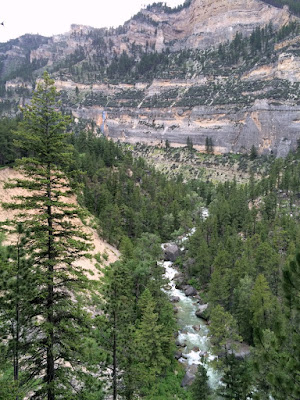 |
A view of the Little Big Horn River, near the Foot Bridge
Aid Station. The water is flowing toward you. |
This was another big stop, but well worth it. Your preparation here can set you up for success or failure in the rest of the race. I now got out my spare pair of shoes and socks I had in my drop bag along with the other usual supplies. I "watered" my feet and dried them off, reapplied some petroleum jelly (to prevent blisters), and put on the new shoes. That felt extremely nice! I was even treated to a cup of coffee and a breakfast sandwich here. Since it was now morning hours the presence of breakfast foods helps you kind of mentally reset to the next day, despite staying up all night. Right out of Footbridge AS we had a massive climb to get up out of the Little Bighorn Canyon. Comradery was provided by several other suffering runners around me. This was a long hike, and even as it leveled out I felt the need to speed walk some portions. The trail was very thin, a literal single-track, that caused for some precarious footing.
I continued refilling and reapplying sunscreen at the intermediate aid stations along the trail. These are a logistical challenge for the volunteers to stock, as they would typically require the supplies to be brought in on horseback! Just goes to show how dedicated the volunteers and race supporters are.
Marveling once again in my surroundings I took another quick stop to take some pictures. Things just kept going at a fairly steady pace until the Dry Fork aid station was within sight. This was a bit of a tease, as you could see it from over 2 miles away!
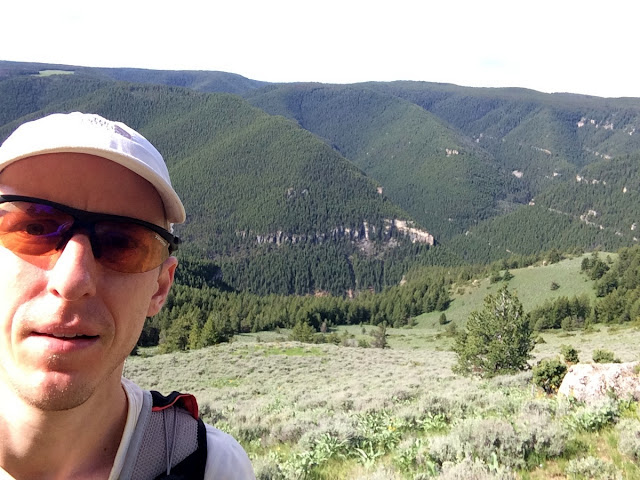 |
| Selfie-break while running up on one of the ridges. |
Dry Fork to Lower Sheep Creek (82.5 - 92.5 mi)
At the Dry Fork Aid Station I was again greeted by some familiar faces, but this time was all business. Restocking, eating and drinking were high priorities. My friends were of great help in
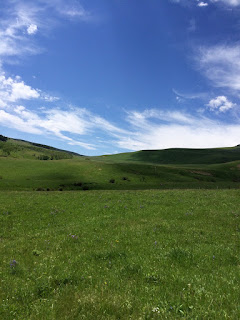 |
| Wide open, alpine spaces high up. |
keeping me calm and on track. Some runners use
hiking poles in more mountainous races (like Big Horn), to assist with the steep ascents and even to help relieve some sore quads on the downhills. I decided to make them optional, but I ended up picking them up here. Though they were annoying to carry at times they were worth having to help me with the uphills.
I felt fatigued, both mentally and physically, but setting out with less than 20 miles to go I knew I could basically speedwalk my way to a finisher belt buckle and that alone was a boost. Back to some rolling hills and tedious single track before one last monster climb up what felt like a 40% incline to the green meadows. One of the toughest parts of the race for me was in the final descent down to the Tongue River Canyon. Attempting to tip-toe down a steep grade when my quads were fatigued was a huge challenge. I couldn't run for fear of falling or hurting something, so I again utilized my poles to trek down.
Now that most of the descending was over with the hiking poles would soon become a nuisance. After buddying up to someone's pacer I was able to leave the poles at an aid station and the pacer knew someone there with a car who was able to transport them to the finish. This made running on flatter surfaces much easier.
My GPS watch, a
Suunto Ambit 2 had worked great, all things considered, but since it only pings a satellite once per minute and then connects the lines the result is a slight under reporting of distance. I think by now I was like 3 miles under the true distance, which kind of played head games with me; "the race says its only 7 miles to go by my watch hasn't hit 90 yet?". All those little tangents drawn over curved paths add up. No watch can last 30+ hours with constant pinging (the most accurate measure), so this is a good compromise. To my amazement I still had like 20% battery life left! Some runners actually recharge their watches during the race with portable USB power sources, but this sounded like a big hassle. Its really nice to have some gauge on how far you ran in the last hour or so, and I love being able to go back after a run and look at my route on a map.
Lower Sheep Creek to Finish in Dayton (92.5 - 100 mi)

It just doesn't get any easier. We were now back into the heat of the canyon in the hottest part of the day, near where the start was, and getting close enough that you could almost taste it. Almost, since it would still be a couple more hours. I refueled in the lower sheep creek aid station and, tempted by a sub 30 hour finish, got a little energy boost that let me run up and down some rolling hills. Once we got back to the original starting line there was an aid station and 5 miles of gravel roads to go. I blew through this one just getting a drink since my pack was still mostly full. This was unwise in hindsight as those last 5 miles were on a completely exposed road, in direct sun, during the heat of the day. I recalled my friend Natalie shouting "Erik, put some ice in your hat!"; she was running the 50 miler and we had been trading spots the last hour or so.
Fortunately, once I got down the road a bit some volunteers were riding around on bicycles handing out ice-pops. I ate 2 which cooled me down and I was able to continue slow jogging toward the finish. Another tiny aid station that just had water was 2 miles from the finish. I recall seeing a runner about 400 meters behind me who appeared to keep gaining on me. I was convinced she was running the 100 and I didn't want to lose a position this late in the race, so this was good motivation to keep up the pace. It turned out she was doing a shorter distance but it still got me moving! As I entered Dayton and closed in on the finish park I was greeted by some enthusiastic friends along with my wife; I called her over and grabbed her hand to run in the last 200 meters with me for a photo finish!
Done! Though I was flirting with a sub 30 hour finish I was very happy to come in at 30 hours and 17 minutes, especially on a day when so many people had issues (heat, altitude, stomach, etc.) that affected their performance. I briefly dipped my legs in the cold creek flowing next to the park to reduce some of the inflammation in my legs and also clean off the dirt. I collected my Big Horn finisher blanket and enjoyed my post race meal. The belt buckles, finisher jackets, and awards were presented the following morning (along with free breakfast) in downtown Sheridan, a slightly larger town in Wyoming where most people were staying. Once back at our hotel I fell asleep at 8pm and slept harder than ever!
Side Notes:
- The scenery at Big Horn was incredible, anytime I needed motivation all I had to do was take a look around. At night (when you couldn't see anything) I would just switch off my headlamp and gaze at the stars.
- The aid stations and volunteers were legendary. The best food, best volunteers, best logistics I've ever seen at a race by far. It was almost too easy: as soon as you roll into an aid station someone has already found you a chair, grabbed your drop bag, offered to fill up your water, and cued up some hot food on the stove.
- Of course Big Horn was "hard", but any 100 miler is going to be difficult and I really never felt "Godawful, stumbling around, put me out of my misery" bad, so I think it went pretty well. The runner support was a huge boost. Looking at it objectively the race is actually considered as a tougher 100 miler, due to the mountainous terrain, exposure, and changing weather conditions. Its one of only a handful of qualifier events for the prestigious Hardrock 100.
- Most of the aid station had similar offerings: water and electrolyte drink; satly and sweet dry snacks like chips, pretzels, or candies; fruit like watermelon, bananas, or oranges; simple sandwiches; some had hot foods like french toast, quesadillas, or even bacon; salty soups or broths were served in the cooler hours of the night. I would typically graze on all of this, and eat extra water-filled fruit during the warm daytime hours. I like to walk out still eating and carrying a little extra; ill stuff a banana in my vest pocket and eat it on the go.
- I use the term ultra-"running" lightly. In races of this distance there is a lot of power hiking when it becomes too steep, careful walking when rocky, and even walk breaks just when you get too tired or are feeling out of it. The goal is just to get to the finish as fast as possible, running optional! There are time limits though, and if you don't make it to an aid station in time you can get timed out and pulled off the course.
- Getting 2 solid nights of sleep was without question critical for success in the race. I never got that tired at any one point, not even at night.
- To my disbelief, I didn't get sun burned at all. This was a big concern, especially being fare skinned and used to running in often shaded east coast woods. I took a lot of precautions including my arm sleeves, hat with ear and neck cover, and liberal amounts of sunscreen. The mud and dirt that would eventually cover my legs probably helped as well.
- Elevation hits everyone differently. While it can be mysterious, I think it helps to incorporate VO2max boosting workouts into your training routine. I believe that while ultra-runners need mountainous, trail training runs, a significant benefit is obtained from running a lot of weekly miles (often on roads), and incorporating tempos and interval sessions to boost your body's ability to process oxygen efficiently. This is the essence of VO2max training theory, heightening the body's maximum oxygen uptake capacity. There is less oxygen at higher elevations, so while you may be a strong climber at sea level, functioning with less oxygen in the air can be daunting.
- It very important to take time off after a race, even if it didn't go well, and even if you Did Not Finish (known as DNF). Your body needs to heal up and your mind must mentally reset to your next goals. If you don't you can risk physical injury, general fatigue, or mental burnout. Avoid the temptation to just say the race was training for the next race, trying to redeem yourself by running another one too soon, or generally not taking time to reflect and record some lessons learned. This being said, its much easier to go into maintenance mode if your race went as planned; and, the more experienced you are with ultras the shorter your recovery typically goes.


















